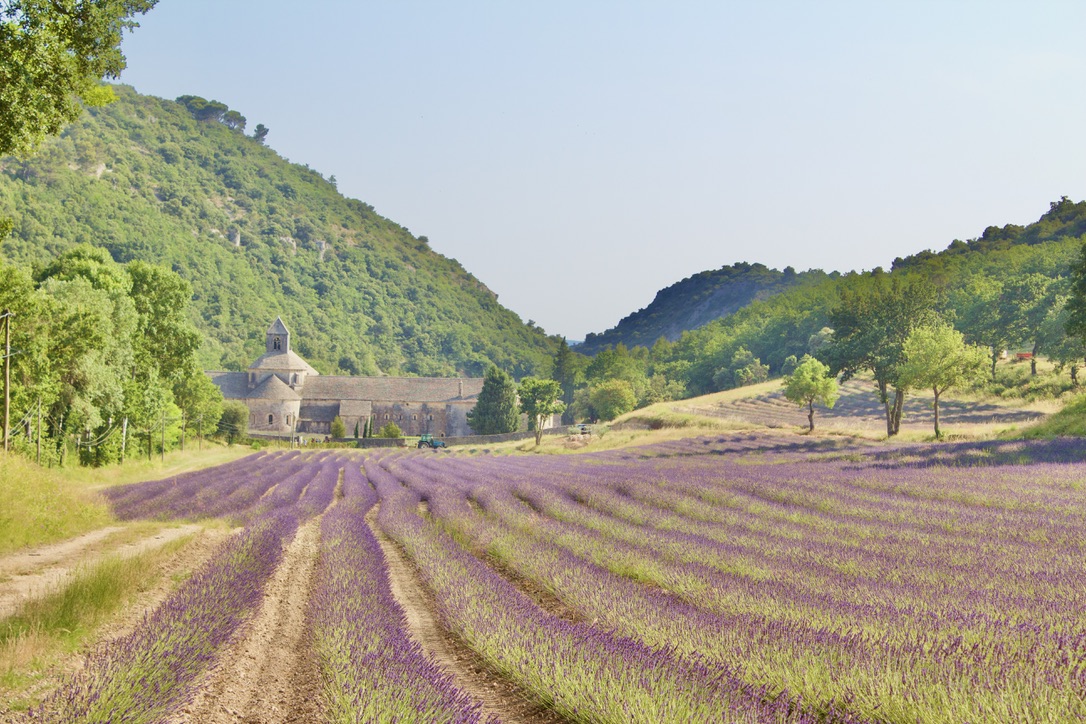ABBEY OF OUR LADY OF SENANQUE
The Notre-Dame de Sénanque Abbey dating from the 12th century is located in the commune of Gordes in the Vaucluse department, in the Provence-Alpes-Côte d'Azur region. The abbey of Sénanque* is one of the three Provencal abbeys built in the Cistercian style of the Romanesque period. It has been classified as a "Historic Monument" since 1921.
HISTORY OF THE ABBEY
Founded in 1148, it became an abbey in 1150. It was built from the 12th to the 13th centuries in carved stones, without mortar. The main buildings are the abbey church, the cloister, the heated room and the chapter house.
The abbey Notre-Dame de Senanque is a beautiful presentation of Cistercian art: with a high purity of lines, sobriety and elegance transmitting feelings of harmony and serenity. The Cistercian architectural style is characterized by perfection in simplicity and harmony in rigor, inspired by the ideas of Saint Bernard.
The church is built in the shape of a cross without any decorations inside. Only light, the symbol of God, modulates space. The heater room, the only heated room in the monastery, is used by the monks to work. It served as a scriptorium, where the manuscripts were copied. The chapter house or chapter room served for meetings of the monastic community for listening to a chapter, for decision-making or for the election of Father Abbot. This is the only room where it allowed to speak.
From the 12th – 13th centuries, the Abbey of Senanque prospered thanks to the donations of the family of Provence Simiane and the lords of Venasque.
In the 14th century, decadence descended upon the community. During the wars of religion, monks were hanged and the monastery was set aflame. At the end of the 17th century, only two monks remained in Sénanque.
In 1791, the Abbey was sold as national property. Repurchased by the Abbot of Lérins, in 1857, it was repopulated by 72 monks. In 1903 the monks were expelled and the monastic life resumed in 1926. In 1969 there were only five monks who could not provide for the maintenance of the monastery. At that time, they rejoined their mother house, the Lérins Abbey. Following an industrial sponsorship agreement for 30 years between the Abbot of Lérins and Paul Berliet, Berliet undertakes to preserve the cultural aspect of the site, to restore and maintain the buildings. Restoration works allowed the monks to reintegrate the Abbey in 1988. In 2012, there are ten settled in Sénanque.
Today, as a priory of the Abbey of Lérins, the Cistercian monastery is active.
SÉNANQUE ABBEY: MONASTIC LIFE
The foundation of the abbey of Senanque was linked to the expansion of the order of Citeaux in the 12th century. At that time, many faithful sought "new ways of religious inspiration", a more severe path towards perfection, a return to the original values and canons (laws).
The order of Citeaux had as its aim to promote asceticism, with liturgical rigor, as well as labor as a cardinal value.
Socially, order plays the role of guarantor of the development of the intellectual domains, the arts and spirituality.
THE ABBEY OF SENANQUE: ECONOMIC LIFE
The economy of the abbey, until the middle of the 13th century, was organized around agriculture and livestock. The isolation prescribed by the law of St. Benedict is relavant to Senanque.
The lay brothers were responsible for the exploitation of the territories of the abbey.
Since the resumption of the monastic life at the Abbey in the 21st century, the work of the brothers has been closely tied to two sectors of activity: agriculture (lavender, honey, forest) and the reception of retreatants in the hotel industry.
Lavandin has been grown in Sénanque since the late 1960s. Lavandin is a hybrid variety, between true lavender and lavender aspic. It blooms from the end of June. It is harvested from late July to early August. The crop is used to produce an essential oil.
To visit the Abbey silence required.
Address: D117, 84220 Gordes
* Three Provençal abbeys were built in the Cistercian style of the Romanesque period: the abbey of Thoronet, located in the commune of Thoronet in the Var department, Notre-Dame de Senanque abbey, and the abbey of Silvacane, located in the commune of Roque-d'Anthéron, in the department of Bouches-du-Rhône.




